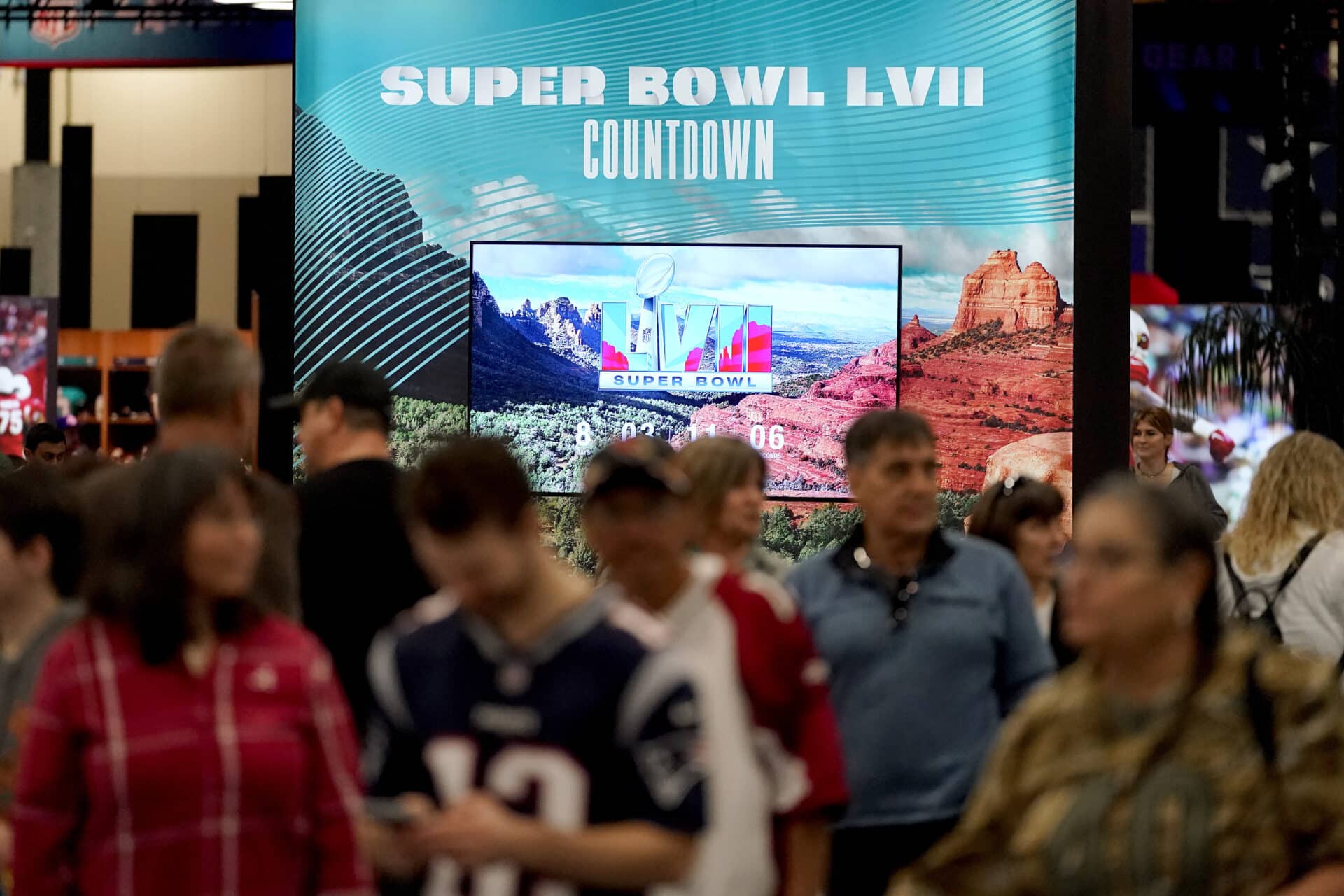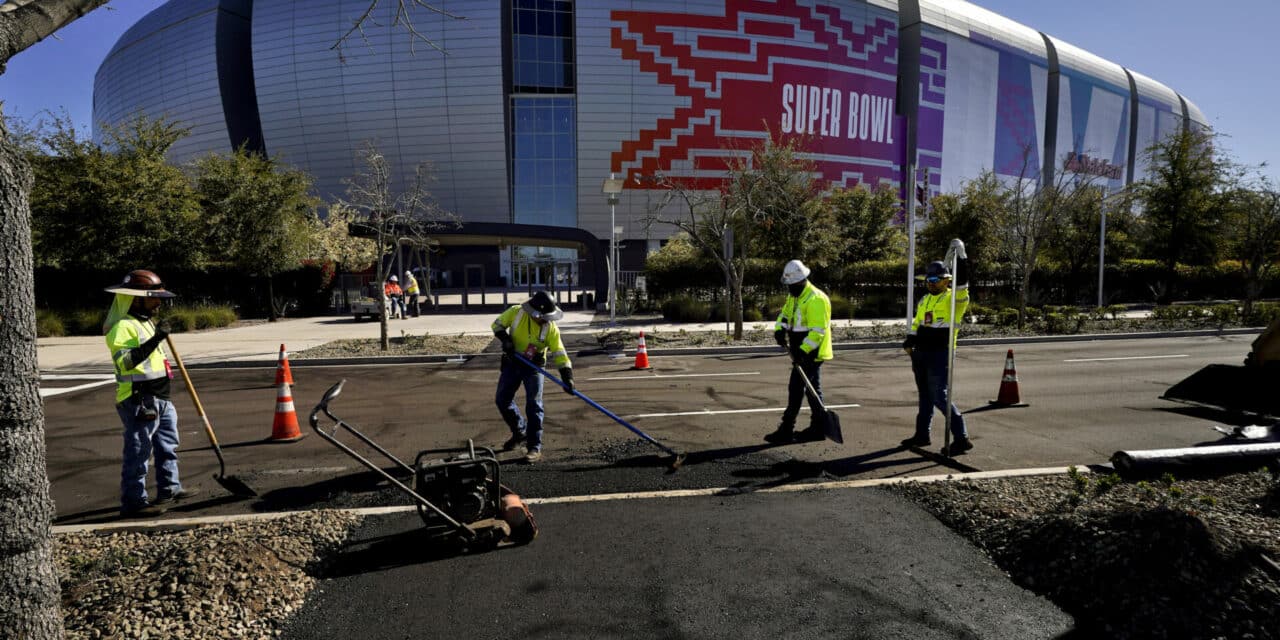SUPER PREP: Workers prepare for Super Bowl LVII outside State Farm Stadium in Glendale, Arizona. (AP Photo)
As the most-watched sporting event in the United States, it may come as no surprise that the Super Bowl ranks on a similar scale when it comes to boots on the ground.
“There’s a tremendous amount of activity going on,” said Mark Camillo, Contemporary Services Corporation senior policy advisor, from Arizona early this week ahead of Super Bowl LVII at State Farm Stadium in Glendale, Arizona. CSC is handling staffing and event security at the game itself, after running security operations at last year’s Super Bowl, which took place at SoFi Stadium in Los Angeles.
“They’re all operating through a secure perimeter, so checkpoints are up and access control is in place,” Camillo said. “There’s still a tremendous amount of build-out occurring here. It’s quite a show that most people wouldn’t realize the complex detail that’s behind this kind of mega event with a football game somewhere in the middle.”
Camillo says his role in the event is to ensure operations are running effectively, while finding ways to refine and improve any vulnerabilities.
“Once the screening operations and the access control checkpoints are staffed and operating, then assessments start to occur basically to test the different checkpoints to make sure they’re operating properly,” he said. “If there is something found that needs to be corrected, then it moves up to a higher level and they quickly move to close that gap. It’s about identifying vulnerabilities, closing them and validating good operations.”
Getting to this point has meant early preparations.
“There is no break in planning,” Camillo said. “They start to redirect their focus on the next Super Bowl right after the completion of the current one. It’s an extraordinary amount of training. This receives SEAR-1 (special event assessment rating) from the federal government, and that rating provides resources that normally would not be made available. There’s a lot of moving parts on the private sector side and government side. They partner and work very closely with the state and local public safety entities.”
The combination of large in-person attendance, worldwide viewership and VIPs on and off the field make the event difficult to rank on a security level.
“The Super Bowl is probably the most high-profile sports event in the United States,” said Jim Hayes, vice president of sports and entertainment for Guidepost Solutions, which among its services develops security design for sports venues. Hayes’ experience includes as a special agent at the Department of Homeland Security’s New York Field Office. He says the magnitude and detail involved in the Super Bowl is only rivaled, in his experience, by the United Nations general assembly.
“It’s one of the few sporting events designated as national special security events by the Department of Homeland Security,” he said. “That means a federal coordinator who works with venue security and local law enforcement is there to coordinate all security aspects. They close off the airspace for these events. There’s a lot more that goes into it just because of the high profile nature of a game like the Super Bowl.”
Hayes, who has experience from Super Bowl at MetLife Stadium in 2014, says the public/private nature of the event’s logistics makes the event unique, with high-profile attendees such as world leaders, celebrities and others who often require their own security detail.
With the Super Bowl being more than just one football game, the security implications are similarly varied, with events taking place throughout the week in various locations.

ARE YOU EXPERIENCED: Fans enjoy the festivities during the Super Bowl Experience at the Phoenix Convention Center Feb. 4. (AP Photo)
Best Crowd Management and Event Security Services is handling security operations and guest services personnel for the Super Bowl Experience taking place at the Phoenix Convention Center in the week leading up to the Super Bowl, as well as for the league hotel and accreditation center, media and NFL Honors event taking place tonight at Symphony Hall in Phoenix, hosted by Kelly Clarkson. The company is staffing more than 800 people for the Super Bowl-related events.
“As you’re leading into the events, you’re having to imagine how the facilities are going be used for this large event,” said Jeff Spoerndle, vice president at Best. “Ultimately, it’s the NFL determining how they’re going to use the facilities. We drew over 70,000 people (last) Saturday and Sunday at the convention center for the Super Bowl Experience, and most convention centers are not used to that type of volume. So it’s, how are you going to get creative with crowd flow? How are you going to stagger your security and guest services and law enforcement to manage that, and really look at how you can make a real positive experience for the guests.”
The core crowd management and security operation is heightened to a greater degree, with cooperation between multiple entities, a major difference from typical large-scale events.
“You have what they normally do on any game day — the extended perimeter, the cameras, the monitoring, and then you have this event where you’re now looking at that venue as the other venues that have experiences, pre-parties, after-parties,” Hayes said. “There will be both private security and public security, and they’re working together to create plans and make sure there’s traffic patterns and special cameras set up and drone monitoring making sure that crowd safety and crowd movement is as seamless as possible.”
Technology is going a long way to help manage crowds and increase efficiency in screening, including sophisticated surveillance cameras. “Some of these new camera systems, eight cameras can do the work that five years ago you needed 150 to do,” he said.
Contactless screening is another rapidly changing space, with fans and event managers praising the results.
“Technologies like Open Gate and Evolve, for example, where guests can walk through at a real-time pace and they can detect a weapon, really speeds up the process,” Spoerndle said. “That ultimately keeps the flow going at entry points. The last thing you want is a big pool of people standing outside your, metal detection checkpoint because that’s, in essence, a dirty zone where nobody has been screened and it leaves you vulnerable. Getting through that checkpoint in a quick, efficient and safe manner and making sure that you’re screening for what you need to or prohibit from coming in the venue is critical.”







